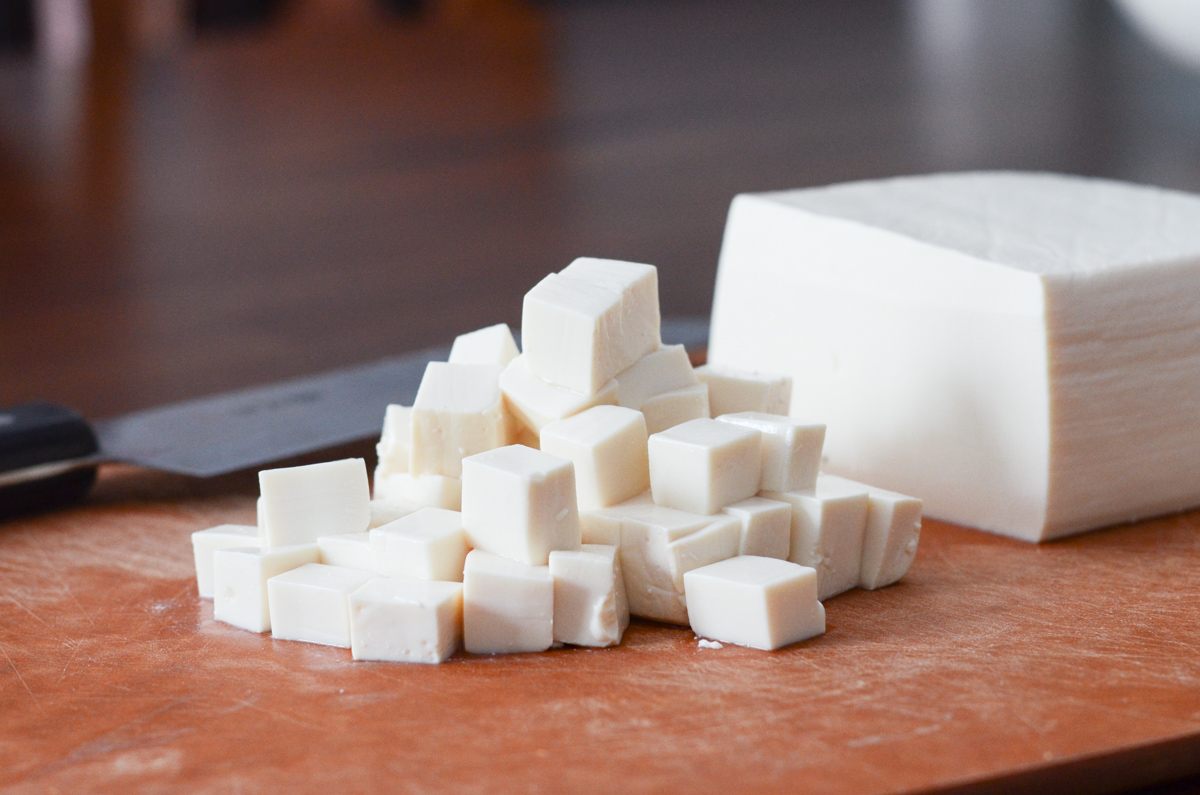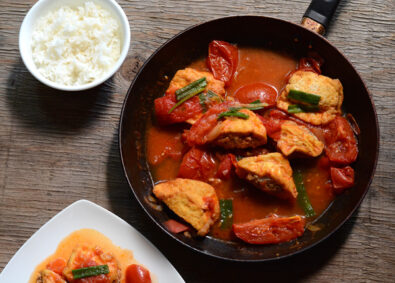
You may have heard of tofu in such dishes as mapo tofu of China, soon tofu of Korea, agedashi tofu of Japan, or dau sot ca chua (or the meat-filled version) of Vietnam. Tofu has made its way through Asia and down to southeast Asia eventually becoming important culinary staple throughout. In its many forms–silken, firm, tofu skin–cooked in many different–fried, raw, frozen, braised–it’s a truly versatile food that finds itself in equally diverse range of dishes.
On this side of the globe, Americans know tofu predominantly as a vegetarian or vegan substitute. In Thai restaurants, tofu is an animal friendly stand-in for meat in curry and noodle dishes. For vegans and vegetarians, tofu can take the place of primary proteins in dishes like scrambled eggs, eggs benedict, club sandwiches and stir-frys. For the lactose-intolerant, soft tofu can be made to replace cheeses like ricotta or the cream components in pies and puddings.
Vegetarians the world over value tofu for its high protein content and relative low calorie count. It packs 10 grams of protein per half a cup serving (124 grams) and is a great source for calcium, magnesium, and phosphorus. In fact, tofu beats beef for protein per gram: For 100 grams, tofu contains 11 grams versus beef’s 8.9! Not only is it great for vegetarians, but also people watching their calorie intake or cholesterol.
Because of its sponge-like structure and neutral flavor, tofu can easily absorb different flavors making it both versatile and confusing. It’s the ultimate Transformer of food and its “flavors in disguise!” J. Kenji Lopez-Alt of Serious Eats declares that tofu is his favorite food. In his recipe for Crispy-Fried Tofu and Broccoli, he describes different methods to transform the texture and flavor of tofu from a wet, soft block to delicately-flavored, crispy pieces.
What is tofu made of?
The ingredient list for tofu is simple: soybeans, water, salt coagulates (calcium, magnesium chlorides or sulfates), and sometimes acid coagulates (citric acid or glucono delta-lactone). The different types of salt and acid coagulates differentiate different styles of tofu. The Chinese style of tofu uses calcium sulphate (aka gypsum) while Japanese style uses magnesium chloride or calcium chloride.
How is tofu made?
In tofu production, the magic lies in its processing. First the soybeans are made into soymilk which is then curdled with different salts as mentioned above. The so-called “soybean curd” is then pressed into that familiar block form. To make “silken” tofu, acid coagulates are introduced creating a jelly-like consistency and imparting a slight sour taste.
Home cooks and hobbyists agree that buying locally-made tofu is preferable to making your own at home. The process of making firm tofu draws some comparisons to cheesemaking, a fussy endeavor that is perhaps not worth the trouble especially if you can find it locally. One DIY recipe that stands out is kinugoshi tofu, a more delicate type of silken tofu that shines with extreme freshness.
Tofu nutrition
As we’ve mentioned before, tofu is a protein-packed powerhouse with more protein per calorie than beef. In addition to its chameleon-like flavor possibilities, its high protein content makes tofu an adequate replacement for meat. While tofu contains all nine amino acids to qualify as a complete protein, David L. Katz, MD states that it is not “as high-quality as animal sources” or unprocessed soybeans based on the proportion of amino acids.
Nonetheless, replacing meat with tofu may have a net beneficial impact especially when replacing meats high in saturated fat. For instance, one hundred grams of tofu contains only 0.9 grams of saturated fat to beef’s six grams.
When it comes to carbs, tofu’s got ‘em. The different types contain on average different amounts of carbs. Per 100 grams of tofu, here are tofu’s carb stats:
- Silken: 1.4g
- Soft: 2g
- Firm: 2.3g
- Extra-firm: 2.6g
For many low-carb vegetarian dieters, tofu can be carefully included for its high protein content and low net carbs.
For all those gluten intolerant out there, rejoice! Tofu is gluten-free and therefore an indispensable source of protein for gluten-free vegetarians. However, please be forewarned! Many flavored tofu products contain soy sauce, a common wheat-based accompaniment.
Raw or simply uncooked?
Note to those raw dieters out there: while it can be eaten uncooked, tofu itself is not considered a raw food because of the heating process used to make curd. Having said that, it can be enjoyed “raw” (rather, uncooked) right out of the package! Recipes like Hiyayakko (Japanese Cold Tofu), Marinated Tofu with Peanuts and Charred Bean Sprouts and Chinese Cold Tofu Salad take advantage of tofu’s subtle, delicate flavor and texture in its most naked form.
We suggest trying uncooked tofu in a traditional recipe to fully appreciate and understand the foundational flavor of tofu. My personal favorite is Tau Hu Nuoc Duong, fresh, warm tofu dessert suspended in a gingery sugar syrup. It’s perfectly adorned with the warm, heat and sweet of the syrup allowing its true natural flavor and texture to shine. It’s also very similar to the Filipino version called taho. It brings out the neutral flavor of tofu, akin to tasting the neutrality of rice in a browned rice tea.
Is tofu good for you? Is tofu bad for you?
The last twenty or so odd years were rife with over-simplified health claims based on association and not causation. We assumed that since Asian people seemed healthy and consumed a lot of soy that it must be healthy. The discovery of isoflavones in soy (an estrogen-like compound) caused a frenzy of studies and claims, many of which have been later challenged and disproven. The latest and most significant study in 2017 from the journal Cancer puts some embattled arguments to rest, proving that not only is soy consumption not harmful for women with breast cancer, it can even be beneficial. Here are our lists of the positives and negatives of soy:
The Good
- Soy is a valuable plant-based protein source, high in fiber, protein and low in saturated fat
- Soy does not increase the risk of breast cancer, even possibly decreasing the risk
- Soy can possibly decrease the risk of gastrointestinal cancers
- Possibly helps protect survivors of prostate cancer
- Soy in moderation may help block disruptive effects of BPA exposure for women undergoing in vitro fertilization, thereby increasing their rate of fertility
- Soy may help 20-50% of American women soothe hot flashes (This study found the opposite to be true.)
The Bad
- Over-processed soy products (like bars and protein-powders) strip away the original health benefits touted in positive studies of soy. Opt for edamame, tofu or tempeh over “frankenfoods” instead.
- Isoflavones may reduce fertility
- Consuming over 100g of soy isoflavones every day (about 16 cups of soy milk–that’s a lot) may reduce ovarian function
- In 2008, the American Heart Association walked back on their claim that soy reduces the risk of heart disease, citing insufficient evidence
- Isoflavones might interfere with thyroid medication absorption, requiring a waiting period of four hours between consumption
Mock meats
Soy is the foundation of many sorts of “mock meats” like hotdogs, sausage, burgers and deli meats. These “frankenfoods”–including health bars and soy protein powders– walk on the “bad” side of soy since they are extremely processed, eliminating much of what makes soybeans and other vegetables healthy in the first place. They may not look unhealthy on paper, still boasting high numbers in protein, but their health benefits may easily be confused with those of healthier products like edamame, tofu or tempeh.
The big takeaway
Our biggest takeaway from this expansive CNN article was that the health benefits of soy are really dependent on its preparation. Physician Dr. Cate Shanahan draws a sharp comparison between the oft-fermented, cultured types of soy foods found in Asian cuisine versus the more processed varieties that end up on American store shelves. Fermentation allows microbes to grow the amount of amino acids, fatty acids and vitamins in soy, creating a much more nutritious food. In short, not all soy is created equal and results can vary drastically.
Tofu brands
The following is a list of common store-bought tofu brands:
- Sun Luck
- Nasoya
- Azumaya
- Trader Joe’s
If you’re looking for the real deal–fresh tofu made daily—it’s worth giving a good ol’ Google search a shot. There may be a local tofu producer in your neighborhood! Most large Asian supermarkets carry a selection of fresh local tofu as well. My parents would buy tofu regularly at our local Vietnamese grocer, including some pre-fried tofu and a quart of fresh soymilk by the same maker.
How long does tofu last?
Tofu usually has a sell-by date printed on its packaging. If unopened, EatByDate states the tofu will stay good for 3-5 days past the date. After it’s opened, you can store the unused portion inside an airtight container, submerged in water that should be changed daily. This will last 3-5 days after opening, regardless of the printed date. We prefer to cook the entire block and store the cooked leftovers instead of the trouble of daily water changes.
To freeze, EatByDate recommends pressing out the liquid and wrapping tightly in plastic wrap before placing into a container. Beware that the texture will change after freezing. (Serious Eats has a recipe for this texturally-altered tofu.)
For local fresh tofu brands, try to consult with them directly. The containers may still be warm and not airtight in contrast to the refrigerated air-sealed blocks of tofu. As you can imagine, this means they have a much shorter shelf-life. Try using your senses to determine freshness. When it goes bad the color may darken, but the most obvious indication is that it will smell and taste sour. Examine and taste it carefully on the first day and check for off changes that indicate its turning.
Types of tofu
The main differentiation between the types of tofu is water content. Generally, less water equals firmer and denser tofu. They are typically four types: Silken or Soft, Medium, Firm, and Extra-firm. Silken tofu contains the most water and is further processed with acid coagulates to add a slight jelly-like quality. Soft tofu is generally used more often for desserts while denser tofus can stand up to the frying and stir-frying of savory dishes.









